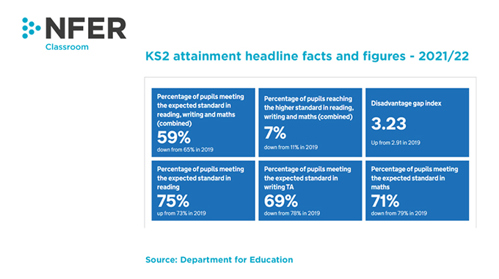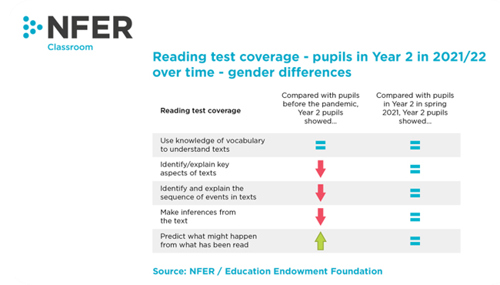Understanding the impact of Covid-19 disruption on the attainment of primary-age pupils
Monday 19 June 2023
 June marks three years since the partial return to face-to-face learning in schools, after the first period of lockdown due to the Covid-19 pandemic. In the intervening years, schools have worked tirelessly to support children in their learning recovery. In the latest edition of our Research Bites series for schools, we look at what the research tells us about pandemic-related attainment gaps in the primary-school age group and the recovery achieved so far. We hope this will help schools as they allocate scarce resources to supporting those children who remain vulnerable to the impacts of the pandemic on their learning.
June marks three years since the partial return to face-to-face learning in schools, after the first period of lockdown due to the Covid-19 pandemic. In the intervening years, schools have worked tirelessly to support children in their learning recovery. In the latest edition of our Research Bites series for schools, we look at what the research tells us about pandemic-related attainment gaps in the primary-school age group and the recovery achieved so far. We hope this will help schools as they allocate scarce resources to supporting those children who remain vulnerable to the impacts of the pandemic on their learning.
Evidence suggests that schooling disruptions during the pandemic caused a slowing of progress for primary-aged pupils, creating a ‘Covid gap’. According to NFER’s summary of the evidence on attainment, by the end of 2020, all primary year groups appeared to have made less progress than in previous years in reading and mathematics. The Spring 2021 partial school closures had a further negative impact, with evidence that the reading attainment of those children in Key Stage 1 in 2020/21 and the maths attainment of those in Key Stage 2 were particularly negatively affected.

In terms of learning recovery, for primary-aged learners, the data suggests the Covid gap was widest in Spring 2021 and has since narrowed. NFER’s longitudinal study, funded by the Education Endowment Foundation, assesses the impact of the pandemic on the attainment of those children who were in Reception and Year 1 during the first period of school closure. Evidence gathered in Spring 2022 suggested many of these children (then in Year 2 and 3) had caught up in terms of reading and maths attainment. However, it is worth noting we also found a large increase in the proportion of the lowest attainers in reading, and to a lesser extent in maths, compared with before the pandemic.
More recently, standardised test data collected in Autumn 2022 by the Education Policy Institute and Renaissance Learning, indicated that, on average, Key Stage 2 children have made less progress in maths than pupils did before the pandemic. However, encouragingly, the gap appears to be closing. The story of recovery in reading is particularly positive, suggesting reading achievement has largely recovered for many KS2 children. This is consistent with the data collected by Rising Stars in Spring 2022.
Last year saw a return to national curriculum testing for Year 6 children and pupils’ performances in these tests reflect the findings outlined above. The percentage of children reaching expected standards declined in maths and writing between 2019 and 2022 but increased slightly in reading.

Schools should be proud of their achievements in fostering the attainment recovery outlined. While this evidence is certainly a reason to be encouraged, it also provides an opportunity to look at who remains vulnerable in terms of learning recovery, what subject areas schools may want to focus support on, as well as how effective support may be implemented.
Who:
The evidence is clear that the effects of school closures were not felt equally among pupils. Specifically, economic disadvantage was associated with lower attainment both before and during the pandemic. Concerningly, the disadvantage gap appears to have widened during periods of the pandemic. For example, during the first year of NFER’s longitudinal study in 2021, data suggested that the disadvantage gap had widened, and did not close the following year. Meanwhile, for key stage 2 pupils, the national curriculum test data from 2022 indicated the disadvantage gap had widened since 2019. This aligns with a recent analysis of Rising Stars data which reports substantial disadvantage gaps remains in both reading and maths across primary school year groups. The evidence therefore suggests that catch up support should focus on very low attaining pupils and closing the disadvantage gap.
What:
Evidence collected during the pandemic showed that the progress of the youngest children was particularly affected, especially in relation to their reading development. Reading progress for those in KS1 during the pandemic, particularly the lowest attainers, continues to be an area of concern. Therefore, schools may want to consider a focus on the development of reading in those children currently in Year 3. Specifically, the research conducted by NFER indicated in the 2021/22 academic year, three areas where attainment was lower than pre-pandemic:
- Identifying and explaining key aspects of texts
- Identifying and explaining the sequence of events in texts
- Making inferences from the text


As outlined, research suggests that key stage 2 children remain behind pre-pandemic counterparts in maths. The evidence suggests focusing on identifying areas in the key stage two maths curriculum with which children are struggling. The Department for Education’s Ready-to-Progress guidance and National Centre for Excellence in the Teaching of Mathematics (NCTEM) supporting resources continue to be relevant to support schools with targeted approach.
How:
Evidence suggests that taking a diagnostic approach and providing short, regular interventions for target children is effective in addressing learning gaps. An increased focus on behaviour for learning is also crucial given the impact of the pandemic on children’s wellbeing and behaviour. Initiatives like small group wellbeing sessions, focused PHSE lessons and a whole school approach to wellbeing are recommended.
As the evidence shows, we are near to closing the Covid gap thanks to the hard work of schools and the pupils themselves. There is, however, still important work to be done. A focused approach to supporting those children who have been most impacted, particularly those from disadvantaged backgrounds, is crucial at this juncture. It is also imperative that schools are provided with the required funding and support in their endeavours to continue to close the attainment gap.
References:
Andrews, J. (2023). Recovering from the Covid-19 pandemic: analysis of Star Assessments. Available: RecoveringFromTheCovid19PandemicMay2023.pdf (epi.org.uk)
Department for Education. (2020). Mathematics guidance: key stages 1 and 2. Available: Mathematics guidance: key stages 1 and 2 (covers years 1 to 6) (publishing.service.gov.uk)
Milanovic, K., Blainey, K. and Hannay, T. (2022) The residual impact of educational disruption on primary school attainment by spring 2022. Available: Spring22_RS_Assessment_white_paper.pdf (risingstars-uk.com)
Milanovic, K., Blainey, K. and Hannay, T. (2023). The ongoing impact of school closures on children from disadvantaged backgrounds. Available: White-paper_Spring23_5-0.pdf (risingstars-uk.com)
NCETM. (2020). Exemplification of Ready-To-Progress Criteria. Available: Exemplification of ready-to-progress criteria | NCETM
Rose, S., Badr, K., Fletcher, L., Paxman, T., Lord, P., Rutt, S., Styles, B. and Twist, L. (2021). Impact of School Closures and Subsequent Support Strategies on Attainment and Socio-Emotional Wellbeing in Key Stage 1: Research Report. Available: https://d2tic4wvo1iusb.cloudfront.net/documents/pages/projects/Impact-on-KS1-Closures-Report.pdf?v=1638448453
Twist, L., Jones, E. and Treleaven, O. (2022). The Impact of Covid-19 on Pupil Attainment [online]. Available: www.nfer.ac.uk/the-impact-of-covid-19-on-pupil-attainment-a-summary-of-research-evidence/
Wheater, R., Rose, S., Ager, R., Liht, J., Styles B. and Twist, L. (2022) Assessing the impact of COVID-19 school closures at KS1 on later pupil outcomes (KS1 and KS2) Available: Impact of Key Stage 1 school closures on later attainment and… | EEF (educationendowmentfoundation.org.uk)
